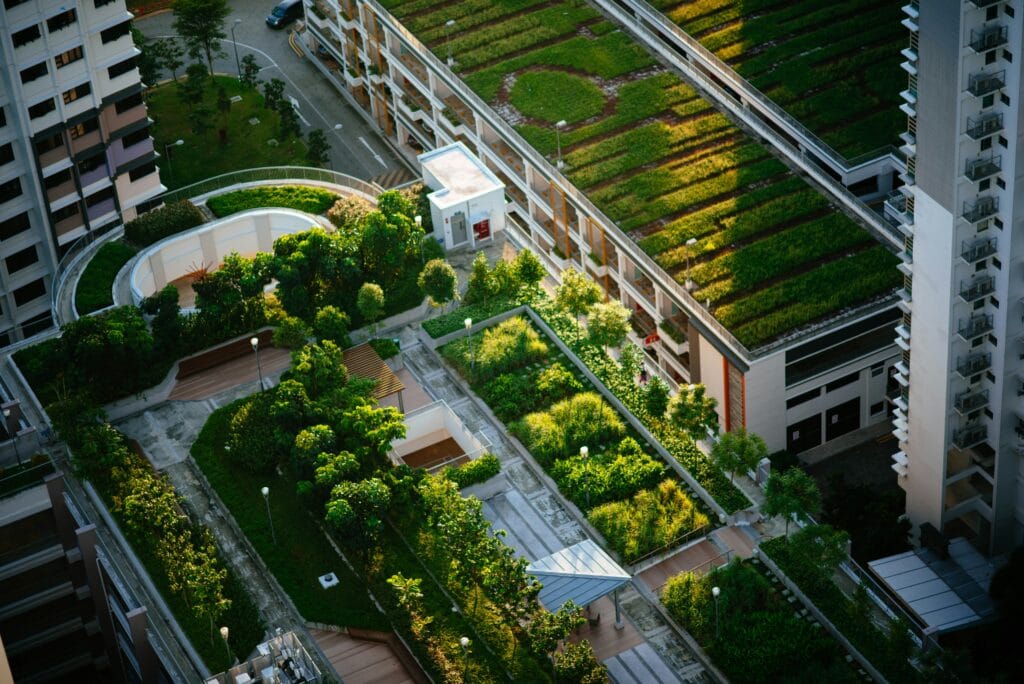As climate change intensifies, the Caribbean faces heightened risks from rising temperatures, more frequent hurricanes, and sea-level rise. These environmental challenges directly threaten public health, economic stability, and the overall quality of life for the region’s inhabitants. Among the innovative solutions available, green roofs—rooftops covered with vegetation and soil layers—offer a promising approach to bolstering resilience. Green roofs can enhance health, improve infrastructure security, and provide long-term benefits to communities by mitigating the effects of climate change and improving environmental sustainability.

The Role of Green Roofs in Improving Health and Quality of Life
Green roofs provide a range of benefits that positively impact health and resilience in the Caribbean:
- Temperature Regulation and Urban Cooling:
- Caribbean cities, particularly in island nations like Jamaica, Barbados, and Trinidad and Tobago, experience urban heat islands where dense development leads to elevated temperatures. Green roofs reduce ambient heat by absorbing sunlight and providing natural insulation. Lower temperatures decrease heat-related illnesses, such as heatstroke and cardiovascular stress, which are particularly concerning for vulnerable populations like the elderly. Given most Caribbean countries currently have an aging population, heat-related illnesses could potentially become overwhelming for that demographic.
- Improved Air Quality:
- Vegetation on green roofs captures particulate matter and filters pollutants from the air. This is critical for reducing respiratory illnesses, such as asthma, which are exacerbated by air pollution. This is a growing issue in many urban centers within the region due to the high importation of vehicles – which emit air pollutants.
- Stormwater Management:
- Intense rainfall and hurricanes lead to flooding, contaminating water supplies and causing disease outbreaks like leptospirosis. Green roofs absorb and store rainwater, reducing runoff and the risk of flooding. In the region hurricanes are frequent, and this can significantly mitigate waterborne health risks.
- Mental Health and Community Well-being:
- Access to green spaces is proven to reduce stress, anxiety, and depression. Green roofs in densely populated urban areas can serve as serene spaces for relaxation, promoting mental well-being and fostering community interaction.
Green Roofs and Resilient Infrastructure
Green roofs contribute to more resilient infrastructure in the Caribbean by:
- Increasing Building Lifespan:
- The vegetation layer protects roofing materials from ultraviolet radiation and extreme weather, reducing maintenance costs and prolonging structural durability.
- Energy Efficiency:
- Natural insulation provided by green roofs reduces cooling costs, making buildings more energy-efficient. This is especially valuable in Caribbean nations where energy costs are high and reliance on imported fossil fuels is significant.
- Biodiversity Enhancement:
- Green roofs create habitats for pollinators and other wildlife, supporting biodiversity in urban environments increasingly threatened by development and climate change.
Strategic Government Policies for Green Roof Implementation
Governments in the Caribbean can play a pivotal role in encouraging green roof adoption through strategic policies:
- Financial Incentives:
- Tax credits, grants, or subsidies can offset the initial costs of green roof installations. For instance, countries could offer incentives for businesses and homeowners installing green roofs, similar to new/existing solar energy rebate programs.
- Building Code Revisions:
- Incorporating green roofs into building codes and development guidelines can make them a standard feature in new construction projects. For example, urban planning authorities could mandate green roofs for commercial buildings to reduce urban heat and improve stormwater management.
- Public Awareness Campaigns:
- Educating communities about the benefits of green roofs and their contribution to climate resilience is crucial. Governments could partner with NGOs to launch campaigns promoting green roofs as an affordable, sustainable solution.
- Research and Development
- Governments can fund research to adapt green roof technologies to Caribbean climates, ensuring optimal plant selection and system design for high heat and hurricane conditions.
- Pilot Projects and Demonstration Sites:
- Establishing green roof pilot projects in schools, hospitals, or government buildings can showcase their benefits and encourage wider adoption.
Long-Term Health and Security Benefits
Strategic adoption of green roofs will yield numerous long-term benefits:
- Enhanced Disaster Preparedness:
- Green roofs mitigate flooding, reduce structural damage from extreme heat, and provide emergency insulation, helping communities recover faster from disasters.
- Health Cost Reductions:
- By improving air quality, reducing heat exposure, and preventing waterborne diseases, green roofs decrease healthcare costs associated with climate-related illnesses.
- Economic Opportunities:
- The green roofing industry can create jobs in installation, maintenance, and plant cultivation, fostering economic growth in sectors aligned with sustainability.
- Climate Change Mitigation:
- Green roofs contribute to carbon sequestration, reducing greenhouse gas emissions and advancing Caribbean nations’ climate goals.
Conclusion
Green roofs represent a transformative opportunity for the Caribbean to address the dual challenges of climate change and public health. By enhancing urban cooling, improving air quality, managing stormwater, and fostering mental well-being, green roofs can significantly elevate the quality of life for Caribbean populations. Governments have a critical role to play in enabling this transformation through targeted policies, financial incentives, and public education. With a concerted effort, the Caribbean can lead the way in integrating nature-based solutions into its urban landscapes, building a healthier, more resilient future for its people.
